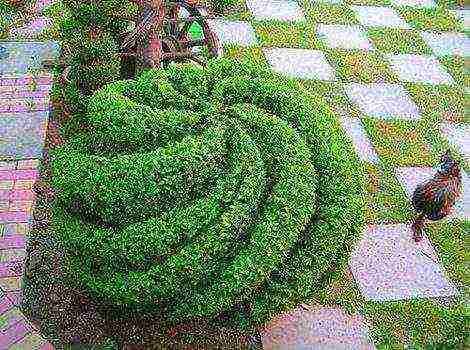Content
- 1 How to grow fruiting figs at home
- 2 Indoor plant fig at home
- 3 Indoor fig care
- 4 Diseases and pests of figs in room conditions
- 5 Conditions and growing figs: how to plant in the country
- 6 How to grow figs from seeds in the garden
- 7 Growing figs in different climatic conditions in Russia and Ukraine
- 8 Landing dates
- 9 Land requirements
- 10 Open ground landing rules
- 11 Caring for figs at home
- 12 Description and types of culture
- 13 Planting seeds
- 14 Care and optimal growing conditions
- 15 Culture transplant
- 16 Reproduction at home
- 17 Possible problems and solutions
- 18 Video: master class on planting culture in the garden
- 19 How to grow fruiting figs?
- 20 Growing homemade figs from cuttings
- 21 Reproduction of figs by planting seeds
- 22 Features of caring for indoor figs
In the potting culture, the fig tree has been used since the 16th century. Home-grown figs produce tasty, healthy fruits that are not inferior in their valuable properties to garden and wild figs. The indoor fig tree is compact, unpretentious, grows well on the windowsill and bears a crop 2 times a year.
Reproduction is carried out by seeds or cuttings. It is recommended to purchase several seedlings, which are grown and then propagated by cuttings, or use ready-made cuttings. The seed propagation method of the fig tree is no less popular. However, when propagated by cuttings, the fruiting of the culture occurs faster.
Low-growing, self-pollinated varieties are used for growing domestic figs:
|
Shuisky |
White Adriatic |
Moison |
|
Black Pearl |
Seedling Oglobin |
Gift to October |
|
Dalmatika |
Kadata |
How to grow fruiting figs at home
In order to grow figs at home using cuttings, fully matured branches of a fruiting fig tree are selected. Rooting is best done in January-February before the plant sheds leaves and begins to grow overgrown with young shoots. Cuttings are cut 10-16 cm long with 3-4 buds. A sharp knife is used to cut them. Sections are dried in a cool place or outdoors for 7 hours. Several small cuts are made in the lower part of the cutting, this will promote better root formation. For rooting, the cuttings are placed in a container with river sand to a depth of 2-4 cm. After that, they are watered and placed under a jar. Prepared cuttings can be placed in a container of water, this will also facilitate rapid rooting.
When the roots grow, the seedlings are transplanted into pots with prepared soil. The soil should be nutritious, drained, contain leaf humus, turf, peat and river sand. After a while, when the root system of the tree grows and fills the entire pot, the indoor figs should be transplanted into a more spacious container with a volume of 6-8 liters.
The fig tree needs regular watering, so during the growing season it is necessary to moisten the soil in a timely manner, otherwise the leaves will begin to curl up and fall off.
Indoor plant fig at home
When propagating by seeds, carefully washed and dried fig seeds are used. Sowing is carried out in early spring. Sowing soil should be light, contain sand, leafy soil and peat. The seeds are placed in the soil at a depth of 3 cm and watered. The container with seeds is covered with glass or plastic wrap. After the appearance of the first shoots, the shelter is removed for 1-2 hours a day, when most of the shoots appear, it is removed. When the seedlings grow up, they are transplanted into separate containers.
Indoor fig care
Indoor figs are taken care of all year round. In summer, the trunk and leaves of the tree are sprayed with warm, settled water, and abundant watering is carried out. When the soil dries up, the fig tree sheds its foliage. In addition, frequent spraying prevents spider mites from developing. During the fruiting period, the amount of watering is reduced so that the fruits do not become watery.
Like all plants of the subtropics, this culture needs a dormant period. To do this, for the winter, the tree is placed on a warmed loggia, in a winter garden or some other cool place where the air temperature does not exceed + 10-15 °; and does not drop below 0 ° C. However, figs can also overwinter at home on a windowsill, far from heating appliances. He does not need lighting during this period. Winter rest lasts from November to January. At this time, the fig tree sheds its leaves. The amount of watering decreases. Watering is required in order to prevent the earthen coma from drying out. Water the dormant plant with cool water to prevent early awakening of the buds. When a tree wakes up (buds swell), it is taken out into the light, provided with regular watering, and top dressing is applied.
For the rapid development of culture and good fruiting, nitrogen is needed, therefore, the first feeding should consist of this fertilizer. When growing figs at home, fertilizer is applied during each transplant. During the swelling of the kidneys, fertilizing from a manure solution is alternated with fertilizing from phosphorus. During the rest period, feeding is not required.
In the spring, when warm weather is established, the container with the plant is placed on the balcony or in the garden.
Young individuals need an annual transplant, since their root system grows very quickly. The transplant is carried out in the spring before the leaves bloom. Trees that have reached 7 years of age are transplanted every 3 years. The new pot should be a few centimeters larger than the old one. In a container that is too spacious, the root system will develop rapidly, which will negatively affect fruiting. When transplanting, drainage is poured onto the bottom of the pot with a layer of about 3 cm. The plant is transplanted so that the root collar remains on the surface. The transplanted tree is placed in a well-lit place.
The formation of the crown plays an important role in the development and fruiting of culture. In addition, if pruning is not carried out on time, figs can grow large in room conditions. It is better to form a crown before the buds swell. In young individuals, 3-4 developed branches are left, the rest are removed. When the plant reaches a height of 20-30 cm, pinch the top to stimulate the development of lateral branches, which are shortened by 1/3 of their length. Shortening the upper branches is necessary to make the lower branches stronger. Pruning is carried out in such a way that the upper buds are not directed to the center of the crown, but to the sides. Correct and regular pruning helps to create a beautiful crown, consisting of 3-4 vertical branches and many side shoots.
You can form the crown in the form of a fan. Fan pruning is quite popular among gardeners, as it increases the yield of the tree and its decorative effect. Crown formation begins with pinching the apical bud. Shoots directed inside the crown and thickening it are removed, the horizontal branches, on which most of the crop is formed, are left. With fan pruning, several main branches remain, located horizontally to the plane and parallel to each other. All sections are made over the kidney. After such pruning, the number of new, fruiting shoots increases.
Subject to all conditions of growing and care, the fig tree begins to bear fruit in the second year. For a year, a houseplant figs can bring 1-2 harvests. The fruits of the first collection are formed on last year's shoots, the second collection - on young shoots of the current year. The first fruiting occurs in July, the second in September.The ripening period for fruits lasts from two weeks to one month. Ripe fruits become soft and begin to secrete sweet juice from the eyes.
Indoor fruit-bearing figs with unusual dissected leaves will become not only a culture that bears tasty, healthy fruits, but also an effective decoration of a room, terrace or garden plot.
Diseases and pests of figs in room conditions
Figs in indoor conditions rarely get sick, but sometimes they can be exposed to diseases and pests. The most common pest of this culture is the spider mite, which develops during the heating season, when the air in the room is warm and dry. In order to prevent the invasion of spider mites, plants and the air around them are sprayed daily. Having found a pest on a tree, the lesions are washed off with a strong pressure of cold water, the leaves and trunk are sprayed with actellik solution. After a week, this procedure is repeated. Of the fungal diseases, the fig tree is prone to coral spotting, which appears as small reddish dots on the stems of the plant. The affected shoots are cut out, the tree is treated with a foundation, a solution of Bordeaux liquid or a solution of potassium manganese.
Despite the fact that figs are considered a subtropical, thermophilic crop, they can also be grown outdoors. The key to the successful growth and development of this plant is not only proper planting and regular care, but also the right choice of a variety that must correspond to the climatic features of the area where it will grow. As practice shows, most varieties of fig trees are low-yielding and do not withstand frosts, reaching below -15 ° C. However, to date, breeders have bred frost-resistant figs that can grow even in the northern regions.
How to grow figs so that the tree produces bountiful, regular harvests? Proper planting will help to grow figs in the garden and protect it from adverse external factors.
The fig tree is unpretentious to soil, tolerates heat and dry air well. The culture is propagated by seeds, cuttings and root suckers. Reproduction by cuttings is carried out before the leaves bloom, in summer or late spring. To do this, take green or lignified cuttings 13-15 cm long with 3-4 buds. On the handle, an oblique cut is made 1.5 cm below the kidney and an even cut, 1 cm above the kidney. After that, the cuttings are placed in a cool, dry place for 6-7 hours so that the milky juice escaping from the cut is dried. Then they are kept for 10-12 hours in a solution of heteroauxin and planted in a container with a previously prepared soil mixture consisting of leaf humus, turf and sand. Expanded clay and steamed soil mixture are poured onto the bottom in a thin layer. Calcined and moistened river sand is poured on top and small depressions are made in it. The distance between the cuttings should be at least 8 cm. The cuttings are placed in the pits and the soil around them is compacted, then watering is carried out. The plants are covered with a glass jar.
When caring for cuttings, it is necessary to constantly maintain the moisture content of the sand. After 1-1.5 months, the cuttings will take root, after another month they can be planted in separate pots with a diameter of about 15 cm. Figs grown in this way begin to bear fruit in the second year. The shoots formed from the root are separated, planted in separate pots. Stretch polyethylene on top. After 4 weeks, the sprouts will take root. After that, the film is opened for a while, thereby allowing the plant to get used to the outside air. The airing time is increased every day.
Fig cuttings are also rooted in water. This method is suitable when there is no prepared planting mixture or sand. Plants are placed in a jar so that their ends are hidden in the water by about 3-4 cm. After 2 days, the water is changed. After a month, the cuttings have roots, after which they are planted in the soil and covered with a film.
When it is not possible to purchase cuttings, figs are grown from seeds. The most common way to grow figs from seed is listed below.
Seeds are sown in a container with a soil mixture, consisting in equal parts of humus and sand, to a depth of 2-3 cm and a distance of 2 cm from each other. After sowing, the soil is moistened, and the pots are covered with glass or plastic. During the period of seed germination, regular watering should be carried out. Seedlings appear in 2-4 weeks. The grown seedlings are planted in separate pots with a diameter of about 10 cm. Fruiting of seedlings occurs in 4-5 years.
The figs are transplanted before the start of the growing season. Young individuals need an annual transplant, 4-5-year-old plants are transplanted as the root system grows. Mature trees are planted in large wooden boxes. With each transplant, the capacity is increased by 1 liter.
When growing figs, it should be remembered that the plant is planted in large pots before the beginning of fruiting, otherwise the tree will grow, and the time of fruiting will be postponed.
Conditions and growing figs: how to plant in the country
How to care for figs? The answer to this question must be known to every gardener who wants to grow a developed, fruiting tree.
The fig tree is moisture-loving and light-requiring, therefore, when growing it, they try to create optimal conditions that fulfill these requirements. The soil must be constantly moistened. During the growing season, frequent and abundant watering is required. Lack of moisture will cause the leaves to curl up and then fall off. With proper cultivation and care, figs bear fruit 2 times a year. The first fruiting occurs in March, the fruits ripen in June. The second fruiting occurs in early August, fruit ripening in late September. In summer, the culture is placed in the open air.
In November, the plant enters the dormant stage and sheds its leaves. For this period, it is placed in a cool place or placed on a windowsill away from heating appliances. Watering is carried out rarely, with the sole purpose that the soil does not dry out. For irrigation, use water at room temperature, but not higher than 18-20 ° C, otherwise the buds will begin to germinate. If green leaves remain on the tree in the fall, a state of dormancy is artificially induced: the number of watering is reduced and the soil is allowed to dry out so that the leaves curl up and fall off.
At the end of the winter rest, the buds open again. The plant is fed with nitrogen-phosphorus fertilizer, watered with manure infusion. During the growing season, fertilizing with organic fertilizers is carried out 2 times a month. To do this, use wood ash, herbaceous infusion or liquid manure. In summer and spring, figs are watered with a solution of ferrous sulfate and fed with microelements. Mature trees are planted in the ground.
How to grow figs from seeds in the garden
To grow a strong, healthy plant on the site, it is important to know how to properly plant figs in the country. First you need to choose a suitable site for planting. A sunny location on the south side of the garden, where there are no tall buildings and vigorous trees, is suitable for growing a fig tree. In addition, the place should be closed from the wind. To protect the thermophilic crop from frost, a trench is dug 1.5 m deep and 1 m wide. Seedlings will be grown in it. The top layer is discarded on the south side, as it will be required for mixing the soil substrate. The soil at depth is poor in nutrients, so it is thrown to the north. If there is heavy loam on the garden plot, drainage (fine stone or sand) is poured onto the bottom of the pit, if sandy loam, drainage is not required.
At the bottom of the trench, holes are made about 50 cm deep. A soil mixture consisting of extracted surface soil mixed with leaf humus, compost and rotted manure is poured into them. In the holes with the soil mixture, seedlings are installed so that the roots are straightened.The seedlings are covered with earth on both sides, while the root collar should remain on the surface.
On the north side, a wall is installed made of polymer material, slate, plywood or white boards. Such a wall will prevent the soil from falling into the pit with seedlings, in addition, its light side will reflect the sun's rays, and will make the illumination of the trees uniform.
The deep trenches also serve to protect the figs from the winter frost. With proper cover from above, the trees will remain in the non-freezing soil zone, since the soil freezes to a depth of about 1 m.With this method, figs in the open field will overwinter well and give a rich harvest.
Caring for planted figs involves shaping the crown of the tree. The most preferred form for this crop by gardeners in terms of yield, compactness and decorative appeal is Verrier's palmette. To obtain this shape, you will need a trellis made of wire or wooden slats. The trellis should look like a checkerboard, where the size of each cell is 20 cm. The formed figs are tied to the cells. In a one-year-old seedling, 3 upper shoots are left at a height of 20 cm. One of them is allowed to go vertically upward, cutting it off several times during the summer, thereby limiting its growth. Two side shoots are tied to a trellis in different directions from each other. Thus, a kind of trident should turn out. As soon as the shoots grow up to 100 cm, they are bent to the ground. The following spring, the central trunk is cut 20 cm above the first tier of branches. After that, the same operations are performed. However, the lateral shoots should now grow 20 cm shorter than the lower tier of the branches,
only then are they bent to the ground. Such work is carried out before the growth of the fourth and fifth tiers, which will be the last. The two side branches remain and are led away in different directions parallel to the soil. After they grow another 10 cm, they are allowed to stand vertically. The result is a beautiful, compact crown.
When growing figs in the open field, when the average daily temperatures reach + 5, + 2 ° C, they begin to hide it. Autumn covering structures are removed, the branches protruding above the level of the northern wall are bent to the ground, boards or plywood are laid on top of the pit, a dense film is laid on top, which is then covered with a layer of earth about 15 cm thick.The soil on top of the film will prevent severe frosts from entering the trench. In the spring by mid-April, the shelter is removed, a greenhouse made of cellular polycarbonate is installed over the open bushes. This material is durable, wear-resistant and keeps temperature well. On sunny days in warm weather, the greenhouse is opened. Once summer temperatures have been established, the greenhouse is cleaned until mid-September, when the threat of frost returns. Such conditions for growing figs are optimal for this subtropical plant.
Many gardeners dream of growing a wide variety of different crops on their plots. Figs belong to exotic fruits. It has an unusual taste and many useful properties.... The only drawback is the thermophilicity of the plant. Let's talk in more detail about growing figs at home.
Growing figs in different climatic conditions in Russia and Ukraine
Figs do not tolerate cold weather and it is possible to grow such a plant fully and carefree only in southern regions with a subtropical climate and air temperature not lower than 20 degrees.
There are also several ways in which figs can be grown in central Russia and the Moscow region:
- in greenhouses;
- at home, as a houseplant;
- when planting a plant in open ground, it must be carefully covered for the winter.
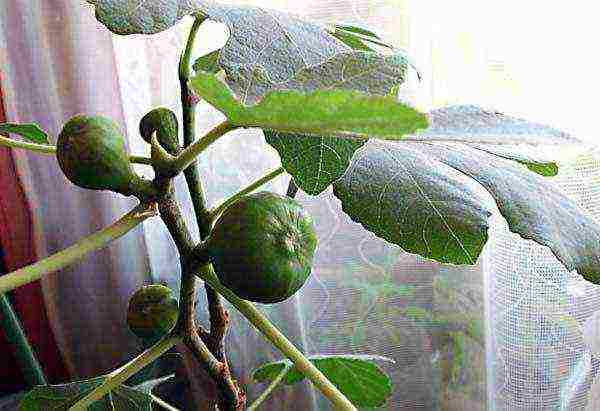 Figs can be grown at home as a houseplant
Figs can be grown at home as a houseplant
If the fig grows at home, then it is recommended for the spring-summer period, bury it directly with a pot in the ground in the garden, and in the fall, move it back to the room.
It is best for wintering to take place in conditions close to its natural habitat, that is, instead of a warm room, it is preferable to place the plant in a basement with a temperature of 0 to -5 degrees.
A winter shelter for outdoor figs should look like this:
- a box with a thickness of 10 centimeters is made of polystyrene, while its length is on average 1 meter, and the width and depth are 50 centimeters;
- the structure is fixed with adhesive tape, and put additional protection upstairs in the form of an old door or window frame;
- as soon as it snows, they can fill the box;
- in May, the shelter is completely removed or instead of the top cover, the surface is covered with plastic wrap, leaving a small gap for air circulation.
Figs are a very capricious culture and can be fully grown only in hot areas. But with a strong desire, this exotic fruit can be obtained in the central part of Russia, Krasnodar Territory and Ukraine.
It is worth remembering that for growing figs in a greenhouse or in open ground with shelter, only low-growing varieties or shrubs, for example, Black Pearl, Dalmatian or Sochi, are suitable.
Landing dates
Considering that figs are very fond of warmth, then it is necessary to plant it only in the spring, so that it has time to properly take root before the first cold weather, otherwise the plant will die. Experienced gardeners identify the exact dates of planting, namely March 15-30., immediately after the start of warming and melting of snow.
Land requirements
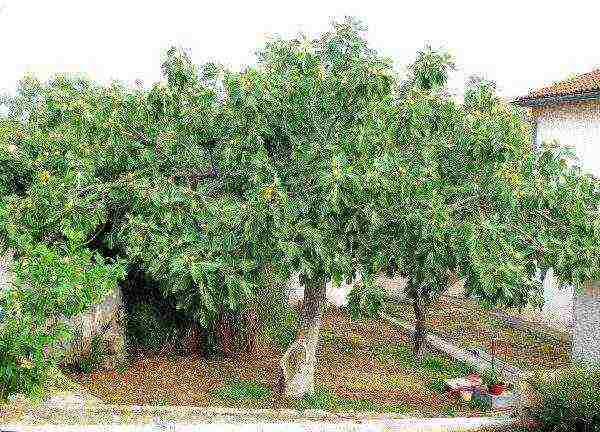 Common figs at their summer cottage
Common figs at their summer cottage
When choosing a place for planting figs, you need to take into account all the features of the plant.:
- The place must be warm and light;
- The best thing avoid draft and gusty winds;
- Experienced gardeners recommend place the tree on the south side in relation to a house, fence or other structure;
- Ground water level should be no higher than 3 meters;
- The plot must be flat, small slope allowed;
- In no case don't plant figs in lowlands.
Since such a tree does not have special requirements for the quality of the earth, it is necessary to dig a hole and fill it with a mixture of:
- the upper fertile soil layer;
- leafy land;
- humus;
- sand.
All ingredients are taken in equal proportions. You can also add a special potting soil mixture for lemon or rose to the dug soil..
Open ground landing rules
A seedling can be obtained in several ways.:
- buy at a store or nursery;
- grow from a bone;
- propagate using cuttings.
For beginners in horticulture, it is best to purchase already grown seedlings, because alternative methods require experience and special attention.
To get a seedling by cuttings, you need:
- In the end of January cut cuttings 10-15 centimeters long with 3-4 kidneys and dry the cut site for about 7-8 hours;
- Several cuts are made in the lower part of the cutting and deepen into river sand by 2-4 centimeters;
- After which they watered abundantly and cover with a jar;
- Also instead of sand you can put the cuttings in water.
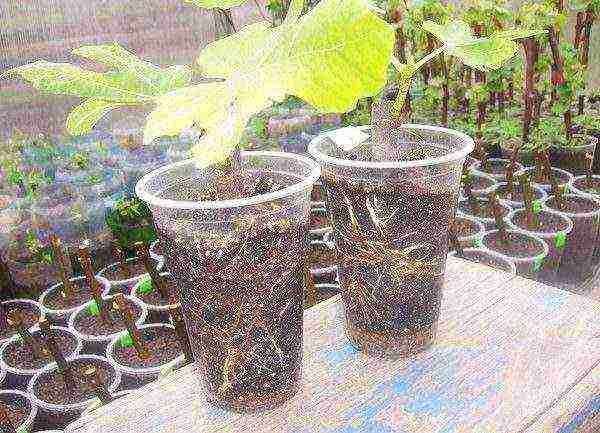 Chopped fig cuttings are rooted both in water and in clean coarse river sand
Chopped fig cuttings are rooted both in water and in clean coarse river sand
And to get a plant from a seed, you must perform the following steps:
- The seed is washed and dry thoroughly;
- In early spring prepare potting mix from the sand of leafy earth and peat and deepen the seeds into it by 2-3 centimeters, after which the soil is watered;
- The container with seedlings must be covered to create a greenhouse effect;
- When shoots appear, they begin take cover gradually, first for an hour, then the time is increased.
As soon as the seedlings, regardless of how they were obtained (by cuttings or from the stone), the roots grow, they are transplanted into pots with a special soil mixture consisting of leaf humus, peat, turf and river sand. As the plant demands, it must be moved to a larger container.
Saplings that have reached 2 years of age can be planted in the garden in the open ground... There are 2 methods for carrying out such work.
Landing in the pits
- Digging holes the depth and diameter of which should be equal 1 meter;
- To the bottom lay out a 30 cm layer of broken brick, and the walls are lined with whole stones. This design will provide good moisture circulation and protect the roots from freezing;
- Part of the soil mixture is spread on the bottom of the pit, then there put seedlings;
- Young the trees are carefully covered with earth, tamped, watered and mulched.
Landing in trenches
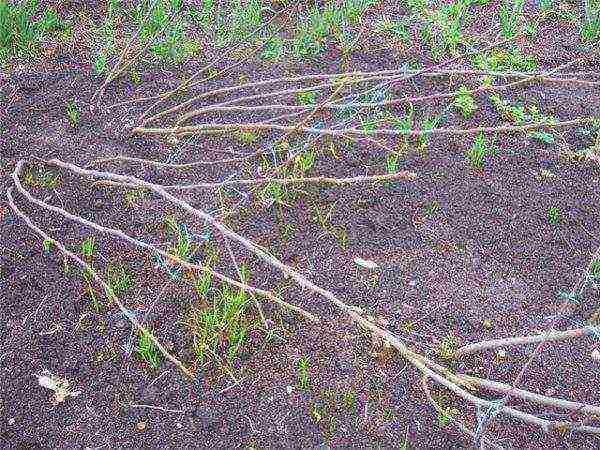 Trench way of planting figs
Trench way of planting figs
This option is best suited for growing bush figs. To complete this landing, you must:
- The length of the trench is calculated based on the number of seedlings, width should be 70 centimeters, and the depth is 90-100 centimeters;
- A layer of crushed stones is placed on the bottom., and bricks or stones are inserted into the walls;
- Then the prepared soil mixture is poured into the trench and make holes for plants;
- Near the landing site support pegs are installed;
- Seedlings are placed at an angleto make it easier to cover the plant for the winter;
- Then trenches are covered with earth, tamped, watered and mulched.
The planting method depends on the type of fig. Trees are planted in holes and bushes in trenches.
Caring for figs at home
Water the tree in such a way that the near-trunk circle is always moistened. During the period of active fruiting, the amount of introduced moisture is reduced... The same goes for the winter season.
In the fall, figs require phosphorus-potassium fertilizers. Early spring it is best to use special complex feeding, in summer the tree will have enough constant mulching of the soil with humus or other organic substances.
In the first years of life, the fig needs a support, which is built from ordinary pegs or trellises.
In the spring, experienced gardeners recommend removing all frozen and diseased branches. Also it is advisable to carry out a shaping pruning, during which the following actions are carried out:
- leave only 2 healthy growth buds, pinch the rest of the shoots;
- at the end of spring, the branches burrow so that the distance between them is about 10-20 centimeters.
In autumn they also carry out sanitary pruning, during which diseased and dry branches are removed.
Also, the care process necessarily includes the protection of the plant in the winter.
In order for figs to give a good harvest, it must be protected from various diseases and pests. Typically, the plant is attacked by fig moth, fig leaf flies and fig aphids.... With regard to diseases, then most often you can observe anthracnose or gray rot on figs.
Preventive measures:
- in late March you need to get rid of insects and various bacteria that have wintered in the tree, for this the tree is treated with an emulsion of mineral oils;
- from the affected branches, you must immediately get rid of and be sure to burn to avoid the spread of the disease;
- at the beginning of August the tree is treated with fugnicides;
- if signs of the appearance of insects still appear, the most effective method is considered spraying with drugscontaining copper in their composition.
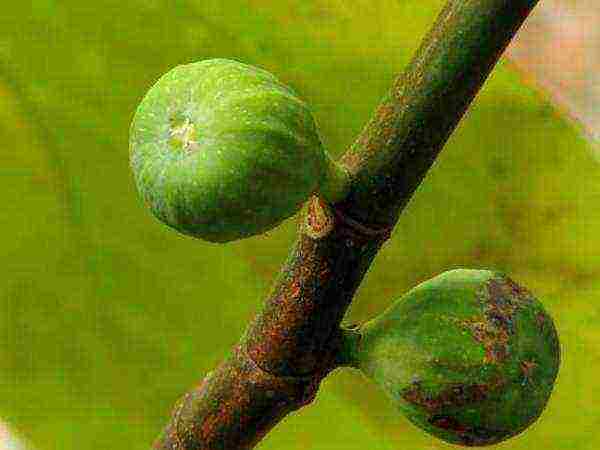 The main pests of figs are fig flies, fig flies and fig aphids.
The main pests of figs are fig flies, fig flies and fig aphids.
Figs are a very tasty and healthy fruit, which, unfortunately, can only be grown in warm climates, in other areas, you will have to take great care of this crop so that it begins to bear fruit.It is necessary to take care of its shelter and create the most comfortable temperature and humidity.
Fig fruits have good taste and a significant number of useful properties. Therefore, many have a desire to grow this plant at home. To do this, you need to know about the special needs of the plant and how to care for it. Before considering how to grow figs at home, let's get acquainted with the characteristics of this culture in more detail.
Description and types of culture

Favorite delicacy of many can be grown in your garden
Fig, which is also called the fig tree, is a representative of the genus ficus of the mulberry family. Despite the fact that this is a subtropical shrub, it grows successfully in cold latitudes - in the territory of eastern, central and western Europe. Figs are resistant to low temperatures, some of its species can withstand frosts down to -20 ° C. This culture is grown not only in the open field, but also at home.
Flowers develop in generative shoots located in the leaf axils. This only applies to female plants. After a certain period of time, the flowers are replaced by seed fruits. As they develop, their size increases, and the shape takes on the shape of a pear. There are seeds inside the seed. Many varieties of figs can be harvested twice a year. Breba (first harvest) ripens by early summer. The second fruiting begins in the first half of autumn.
Varieties of figs
Not all fig varieties are suitable for growing in cold regions. To make the right choice, you need to familiarize yourself in detail with their varieties. So, the most popular types are the following:
- Brunswick is an early variety. The fruits of this fig are elongated and burgundy-greenish in color.
- Brown Turkey is a variety recently created specifically for growing in cold areas. Has a dark brown color.
- Dalmatika is a late variety with good frost resistance. Its fruit can be recognized by its green color and pink flesh.
- Tiger fig is an old variety. Its peculiarity is the appearance of the fruits - they are distinguished by a yellow-green striped color. The pulp has a deep red color, and the taste is distantly reminiscent of strawberries.
- Chicago Hardy - has a high frost resistance.
- Madeleine de De, purple Bordeaux, Violet de Bordeaux - French old varieties. They are distinguished by early fruiting, successfully grow in areas with cold climatic conditions.
- Kadota is a green fig with excellent taste.
Varieties in the photo
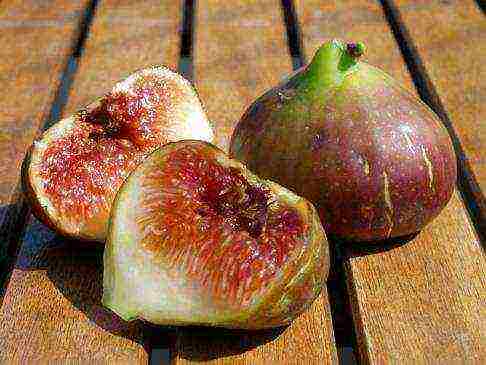
Madeleine de Deux variety is a wonderful healthy delicacy
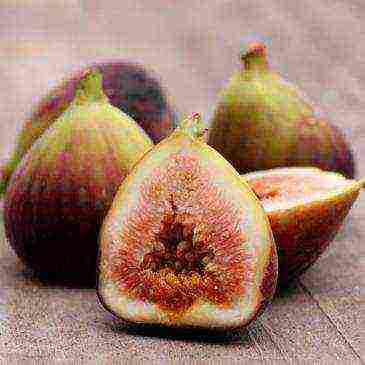
Brown turkey is suitable for growing in cold regions
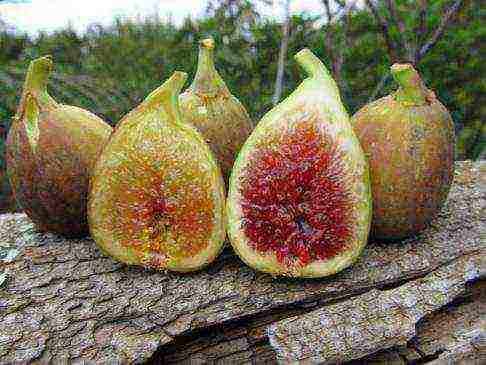
Brunswick is a popular fig variety with juicy fruits
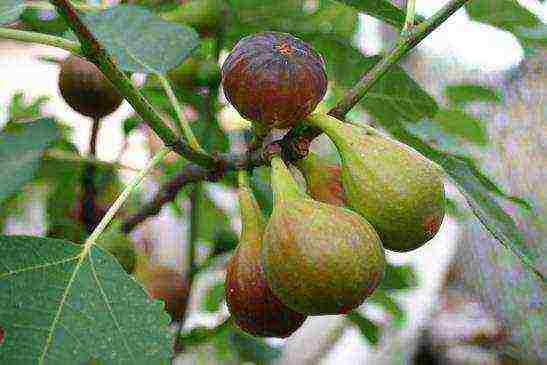
Dalmatian figs are used by many culinary experts
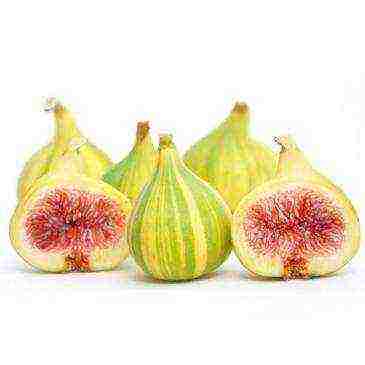
Tiger fig is a rare variety, for which it is more appreciated by gardeners
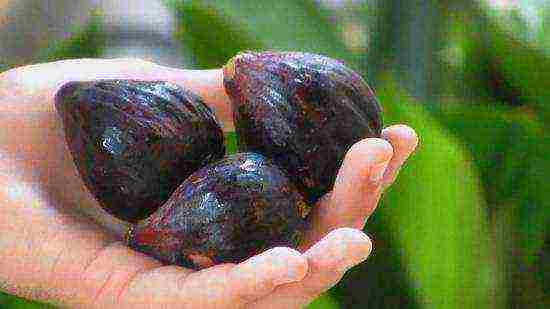
Chicago hardy is not only tasty, but also very healthy

Figs of the Kadota variety have a rich aroma
Planting seeds
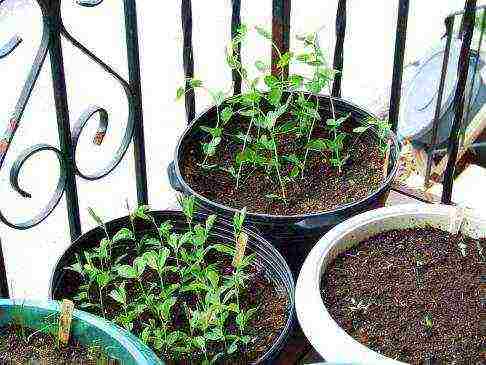
To plant a plant, you do not need special knowledge and skills.
The process of planting fig seeds has the following features:
- To get high-quality planting material, you need to cut the fruit in two and remove the seeds.
- Then they are placed in a fine mesh sieve and washed under running water.
- Next, the seeds need to be dried. To do this, they are laid out on a paper napkin and left for a day.
- After this time, the planting material is ready for use.
- For planting, you need a container. First, drainage is poured to the bottom, then a nutrient substrate. The composition of the soil mixture includes rotted manure, turf soil and sand (it can be replaced with peat) in a ratio of 2: 2: 1. For greater efficiency, wood ash should be added at the rate of 1 tbsp. l. for 1 liter of the mixture.
- The soil must be well moistened, then put a napkin on the surface and sprinkle with a small amount of soil.
- The pot is covered with polyethylene and placed in a place where the temperature reaches 25 ° C.
- The seeds need ample moisture. Perform the treatment daily using soft, constant water at room temperature. Try to water so that the liquid level of 1-2 mm is always kept in the pot pan. This is an important rule, non-observance of which increases the risk of death of the entire crop.
- Crops should be ventilated daily. To do this, remove the bag from the pot and remove the formed condensate. You also need to monitor the level of soil moisture, if necessary, moisten it with a spray bottle.
- After 15-20 days, seedlings will appear. If they are too thick, they should be thinned out. Otherwise, seedlings will not be able to fully develop.
- After the first 2-3 leaves appear, the seedlings can be planted in separate pots and looked after like an adult tree.
Care and optimal growing conditions
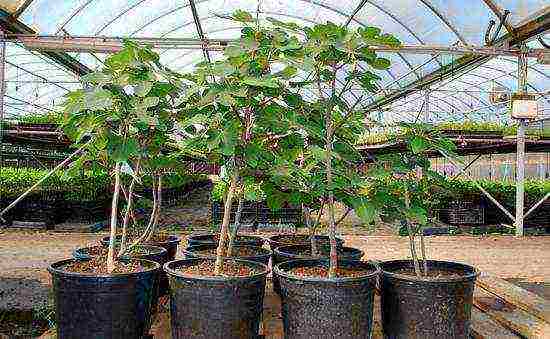
Frequent watering, plenty of light and warmth are important conditions for fruit ripening.
Figs are a moisture-loving culture. Its growing season begins in January and lasts until October. At this time, the plant needs abundant watering. With a lack of moisture, the leaves curl, and the seedlings disappear. Therefore, settled water is used for irrigation. The procedure is carried out as the soil dries.
Important! The level of air humidity does not affect the development of culture.
From October, figs begin to lose their leaves. Then comes a period of rest. It lasts from mid November to the end of December. During the winter, the culture should be at a lower temperature than the rest of the time. Therefore, it must be moved to the window sill and moved as tightly as possible to the window. During this period, the soil is rarely moistened, only to prevent the soil from drying out.
Important! During dormancy, figs should not be watered abundantly.
Another prerequisite for growing a crop is good lighting. Although figs are capable of tolerating shaded areas, they should receive sufficient light during fruiting. It also needs to be fed, especially the plant needs this during active growth. Fertilizers are applied in the first half of January (10-15 days), when the buds begin to swell. Further, feeding is carried out every two weeks, while the composition of nutrients should be alternated:
- Initially, a manure composition is applied, which is prepared at the rate of 5 g of fertilizer per 1 liter of water.
- Then phosphorus feeding is used: 7 g of superphosphate is diluted in the same amount of liquid. Its granules dissolve well under the influence of high temperature, so the composition should be boiled.
- Figs also need potassium trace elements. Top dressing is done as follows: 1 tsp is diluted with 1 liter of water. ash extraction. Before use, the solution is defended throughout the day. Ash can be scattered on the ground and mixed with soil.
- During the growing season, micronutrient fertilizers are applied twice.
- For a period of rest, a break is taken in feeding.

To form the correct crown, the figs must be trimmed
To form the crown, the figs are cut off. This process has the following features:
- Pruning is usually started in early spring. Damaged and crossed branches are subject to removal. And also those that grow inward.
- Excessively long branches should be shortened. In the summer, new shoots are cut. The shortening is done behind the fifth sheet.
- Unripe fruits are harvested in autumn.
Culture transplant
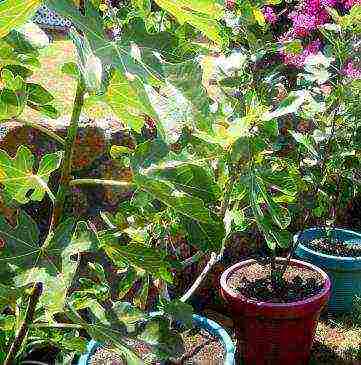
Transplanting will allow the tree to grow stronger
Until the figs reach the age of three, they are transplanted once a year. This process is carried out before the beginning of the growing season, that is, in the last days of December.
Important! An adult culture is transplanted every two years.
A humus mixture is usually used as a soil. You can buy it in the store or prepare it yourself. The mixture includes sand, turf, leafy soil and humus. All components are added in equal amounts.
Flower pots can be used for the first few years. Their size must be increased with each subsequent transplant. The capacity is selected based on the desired dimensions of the plant. The size of a fig depends on the development of its root system. For home growing, containers with a volume of 6-8 liters are used, since they are placed on a standard windowsill.
The transplant takes place in the following sequence of actions:
- Initially, a layer of sand or expanded clay 2 cm thick is poured into the pot.
- Then the fourth part of the container is filled with manure.
- After that, the soil mixture is poured.
- Figs are placed in the central part of the pot and the roots are covered with soil.
- It is necessary to ensure that they do not come into contact with the manure. A small layer of soil should separate the root system from the fertilizer.
The transplanted plant should be well watered. Voids form in the soil, as a result of which too much air appears around the roots. This negatively affects the development of culture. In the process of watering, the voids are filled with water, after it has been absorbed, the soil moves there. Every 14 days, the soil should be enriched with mineral nutrients.
Reproduction at home
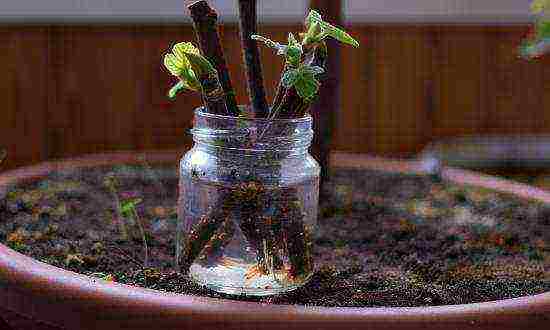
Cutting is the best way to propagate figs
There are several ways to breed figs:
- seminal;
- vegetative;
- with the help of root growth.
The first method to propagate a crop is rarely used, since in this case the crop begins to bear fruit later than when using other options. Also, seed reproduction does not always ensure the preservation of the characteristics of the mother culture. The vegetative method, which is also called grafting, gives better results. Plus, it doesn't require much effort. So, the breeding process is performed in this order:
- Before the growing season, before the growth of buds and the formation of leaves, cuttings up to 15 cm long are cut. Using a napkin, remove the juice in the cut area.
- After the cuttings are placed in a cool dry place for 10 hours. The juice does not need to be removed. But then the planting material needs to be kept in a heteroauxin solution for a day - 1 tablet is used per liter of water.
- River sand is poured into a container with a diameter of 9 to 15 cm and 3 cuttings are buried into it by 2 cm.
- Then the planting material is watered with warm water, the temperature of which should not exceed 25 ° C, and covered with a regular jar.
- After one month, roots will appear. To speed up the process, special conditions must be created for the cuttings - to maintain the soil temperature at 25 ° C.
It is not always possible to detect the formation of the root system in a timely manner. To facilitate this task, it is recommended to plant the cuttings in transparent containers - for example, in plastic cups. When the roots begin to form, they penetrate the walls. Once they are visible, the cuttings should be transplanted into potting soil. To make it, you will need sand, peat, turf and humus.
Important! The formation of the root system indicates the need to transplant the cuttings.
Consider another breeding method that is considered the easiest:
- The fig branches are tilted to the ground and fixed in this position.
- Then sprinkle with soil and watered regularly. After two months, these branches develop their own root system.
- In the second year, new figs will begin to bear fruit. Shovels are separated from the main tree with a shovel and transplanted.
Possible problems and solutions
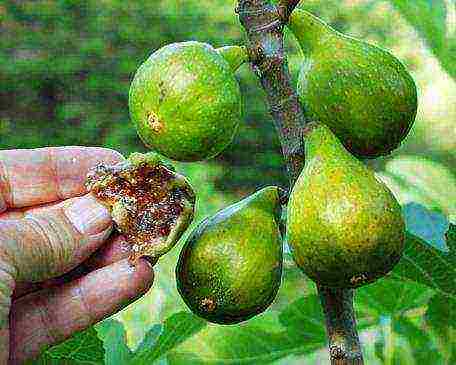
With proper care, figs will delight with an abundant tasty harvest.
Figs, with proper care, are rarely exposed to pests. But you need to pay attention to the formation of the crown.With the intensive development of culture, it grows at a rapid pace. Long shoots must be removed in a timely manner. This will strengthen the lower branches.
The root system of figs can suffer from a lack of air. Regular loosening of the soil will help to avoid this. With insufficient moisture, the culture loses its leaves, therefore, the soil should not be allowed to dry out.
Video: master class on planting culture in the garden
Figs can be called an unpretentious plant. It is able to grow successfully both in subtropical climates and in cold areas, since it is resistant to low temperatures. And also practically not susceptible to the harmful effects of pests. Caring for figs is easy. Creating optimal conditions for its cultivation will allow you to get a high-quality harvest.
Foreword
Fig, it is also a fig tree, a fig tree, a wine berry, a fig - growing this exotic plant at home is a completely doable task. In our country, outdoors, this subtropical deciduous ficus grows and bears fruit in the Caucasus and Crimea. This is one of the oldest, if not the most ancient cultivated plant.
How to grow fruiting figs?
As it turns out, figs began to be grown at home in the 16th century. Its fruits, in taste and content of substances useful for the body, are not inferior to garden or wild figs. The tree is compact, unpretentious, grows well even on the windowsill, bears fruit twice a year.
There are two ways to grow a homemade fig tree:
- by grafting or planting root processes;
- from seeds.
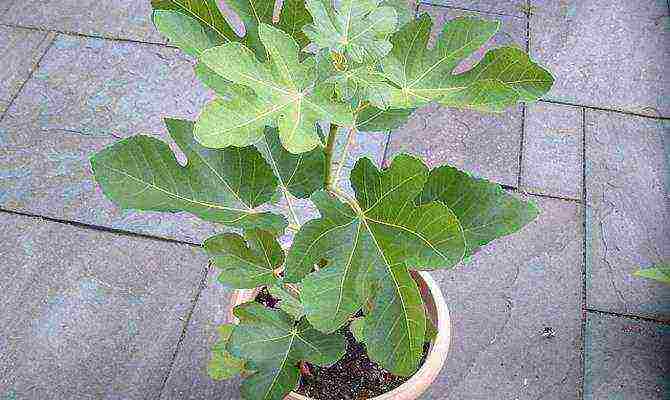
growing figs at home
For the cultivation of a fig tree, ordinary soil, mixed with a small amount of river sand and leafy humus, can be used, to which a little lime or ash should be added. It is not bad if you add a little mixture of finely ground eggshell and peat.
Growing homemade figs from cuttings
The easiest way is to plant cuttings that are cut from the fruiting figs. They will be more hardy if perfectly ripe branches are cut from the bottom of the tree. Cuttings root better if cut in January or February before the plants shed their leaves and start growing young shoots. The length of blanks for cuttings is about 10-15 cm, each of them should have 3-4 buds.

Fig tree shoots
Cutting is done with a sharp knife. The upper cuts of the cuttings remain straight, but the lower ones are made oblique and several longitudinal small cuts are applied to them - in this case, the roots are better formed. Sections are dried in the open air in cool conditions until the milky juice hardens (6-7 hours).
Fig seedlings adapt faster if they are first placed in a heteroauxin solution for 10-12 hours. There are three ways to carry out the process of rooting cuttings:
- By placing them in a vessel of water.
- By planting in a box or vessel with wet sand.
- By planting the stalk in a small pot specially prepared for this. Drainage (expanded clay) should be poured on the bottom of the container, steamed soil should be laid on it, and sprinkled on top with a thin layer of steamed sand. Before planting, the cutting should be washed with water, placed in a prepared shallow hole and slightly crushed around the ground.
In all three cases, the seedlings are covered with suitable glass vessels on top and they try to ensure a constant temperature in the room, where it should be light and warm. In the second and third methods, sand or soil must be systematically watered with slightly warmed (but not hot!) Water. The glass covers should be removed periodically to ventilate the plants.
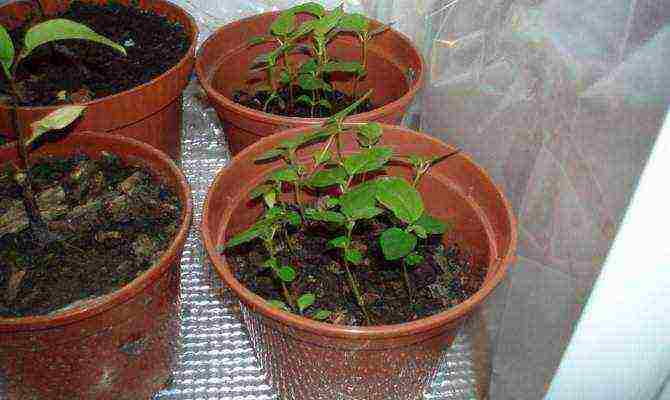
Growing figs in a pot
After about a month, cuttings that have taken root by this time can be transplanted into pots with prepared soil.At the bottom of them, there should also be drainage from a porous material, and the surface of the soil should be sprinkled with steamed sand. Cuttings rooted in the third way are transferred along with a lump of earth to their permanent place and watered with a weak solution of potassium permanganate (potassium permanganate).
Since it is not always possible to find a tree from which you can cut cuttings, you should purchase ready-made cuttings or seedlings. Sometimes the seedlings are grown and then cut into several cuttings. With cuttings propagation, the first fruits can sometimes be obtained within a year after planting the seedling.
Reproduction of figs by planting seeds
To obtain fig seeds, healthy and large fruits are chosen. The seeds taken out of them are carefully washed with water, and then dried within 24 hours. Seeds are planted in prepared soil in early spring.
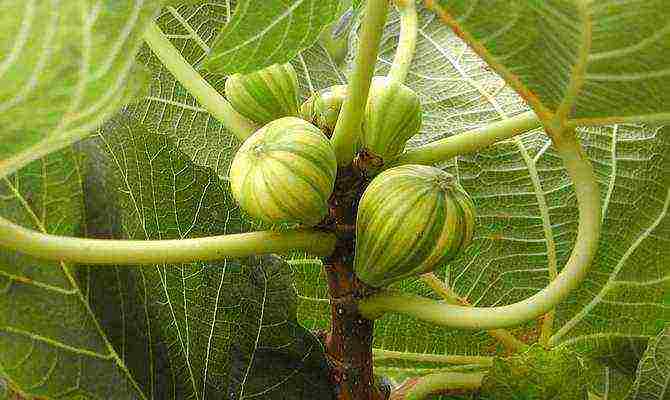
Fig tree fruit
Seeds are planted to a depth of 2-3 cm and not very abundant watering is carried out. The container with the planted seeds is covered with glass or polyethylene. After the first shoots appear, the coating is removed for several hours a day so that the plants can breathe. When the seedlings are old enough, they need to be transplanted into containers of suitable sizes. The first fruits with this method of reproduction usually appear 4-5 years after planting.
Features of caring for indoor figs
It is very important to spray the trunks and leaves of fig trees with settled warm water all year round and water it abundantly. If the soil is allowed to dry out, the tree can shed its foliage. In addition, spraying helps prevent spider mites. The intensity of watering should be reduced during fruiting - the fruits may become watery.
Like any subtropical plant, home-grown figs have a dormant period. In this plant, it lasts from November to January. Therefore, for this time, it should be placed in a cool (with a temperature not higher than +15 and not lower than 0 ° C) and shaded place. The number of irrigations is also reduced, and the water for them must be cool. Trees shed their leaves during this period.
When the buds begin to wake up, the plant needs to be taken out into the light, it should be regularly watered, fertilized with nitrogen fertilizers. Nitrogen is needed for intensive fruiting. And during periods when the buds swell, tree care includes alternating fertilizing from phosphorus fertilizers and manure solution.
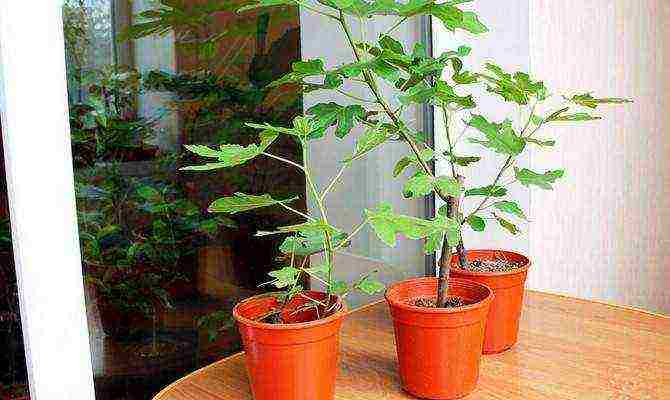
Abundant light is essential for figs to grow
Up to 7 years old, an indoor fig tree, which has a rapidly growing root system, should be transplanted into a larger pot every spring before opening the leaves. After that, the transplant is carried out every three years. Bottom drainage is still needed. After transplanting, the tree must be exposed to light.
It is very important to form the crown correctly, especially since the tree can become too large without pruning. Its formation begins by pinching the apical buds. It is better to prune before the buds swell so that the upper shoots are directed to the sides, and not inside the crown. Shoots growing inward are removed. Mainly the upper branches are shortened, due to which the lateral and lower branches become stronger. So you can grow a tree with a beautiful crown.
Figs at home during the year can give 1 or 2 crops. With two harvests, the first ripens in July and the next in September. Ripening lasts about a month. The ripe fruit becomes soft and begins to secrete sweet juice from the eyes. One well-groomed tree can produce more than one kilogram of tasty and healthy fruits per season.
It remains to add that due to the unusual dissected leaves, figs can also become a spectacular decoration of the home.
Rate the article:
(1 vote, average: 5 out of 5)

